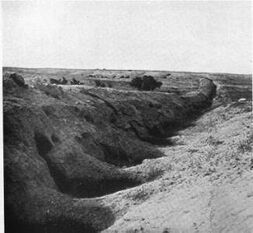
A typical Anti-Tank Ditch in North Africa, 1943
An Anti-Tank Ditch is an anti-tank fortification that was used extensively during WWII by almost every country that fought. It consists of a large ditch that is dug usually in front of strategic areas. The ditch can be surrounded by barbed wire and is dug to a depth of about 2.4 meters. The total length of a ditch can be as much as 4.8 kilometers while the length across is usually about 6 meters.[1]
Some can be up to 18.2 meters across if necessary though. An Anti-Tank Ditch works by having a tank try to cross it and making the tank fall in to the ditch to a point where it cannot go forwards or backwards, therefore it is disabled.
Along with barbed wire, AT Ditches can be placed with other anti-tank fortifications such as Dragon's Teeth and Czech Hedgehogs.
History[]
Anti-Tank Ditches were first pioneered by Germany in WWI when there came a need to stop the allied tank offensives. Since the tank was brand new at the time, Germany tried to develop any weapon they could to stop the tank onslaught and so they opted for a trench/ditch that could stop tanks. Ever since the first AT Ditches, the way of making them hadn't changed much when WWII began.
They were usually made with the use of hundreds of volunteers or regular soldiers using entrenchment tools. AT Ditches were used throughout WWII by many countries. One notable usage of the AT Ditch was when the Soviets dug hundreds of ditches using a civilian workforce during the Battle of Kursk. German forces also dug many ditches to stop Soviet tanks from entering Berlin in 1945.
